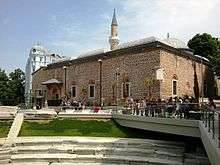Dzhumaya Mosque
| Dzhumaya Mosque Cuma Camii | |
|---|---|
 View of the main façade from the main square | |
| Basic information | |
| Location |
|
| Geographic coordinates | 42°08′52″N 24°44′54″E / 42.1479°N 24.7483°ECoordinates: 42°08′52″N 24°44′54″E / 42.1479°N 24.7483°E |
| Affiliation | Islam |
| Status | Active |
| Architectural description | |
| Architectural style | Ottoman-Turkish architecture |
| Completed | 15th century |
| Length | 33m |
| Width | 27m |
| Dome(s) | 9 |
| Minaret(s) | 1 |
Dzhumaya Mosque is located in Plovdiv, Plovdiv Province, Bulgaria. Its Turkish name is Hüdavendigâr Camii or Cuma Camii. The mosque is located in the centre of Plovdiv and was built in 1363–1364 on the site of the Sveta Petka Tarnovska Cathedral Church after the conquest of Plovdiv by the Ottoman army. During the reign of Sultan Murad II in the 15th century the old building was demolished and replaced by the modern-day mosque. It was called Ulu Dzhumaya Mosque, or Main Friday Mosque.[1]
The mosque is large, with nine domes and a 33 m × 27 m (108 ft × 89 ft) prayer hall. There is a minaret at the northeast corner of the main façade. Interior wall paintings date to the late 18th to early 19th centuries.[1]
2014 attack
The mosque was attacked by a mob described as "hundreds of nationalists, fascists and football hooligans"[2] in February 2014.[3][4] 120 were "detained" after the attack[4] and four received minor sentences.[3] The Grand Mufti of Bulgaria, Mustafa Haci, characterized the attack as a "pogrom."[2]
References
- 1 2 "Dzhumaya Mosque - Plovdiv". bulgariatravel.org. Retrieved 22 March 2016.
- 1 2 "European Muslims respond to attacks on Mosque in Bulgaria". The Muslim Times. 16 February 2014. Retrieved 22 March 2014.
- 1 2 "4 Sentenced after Bulgaria Mosque Attack". Novinite. 15 February 2014. Retrieved 22 March 2016.
- 1 2 "Bulgarian police detain 120 after mosque attack". Reuters. 14 February 2014. Retrieved 22 March 2016.